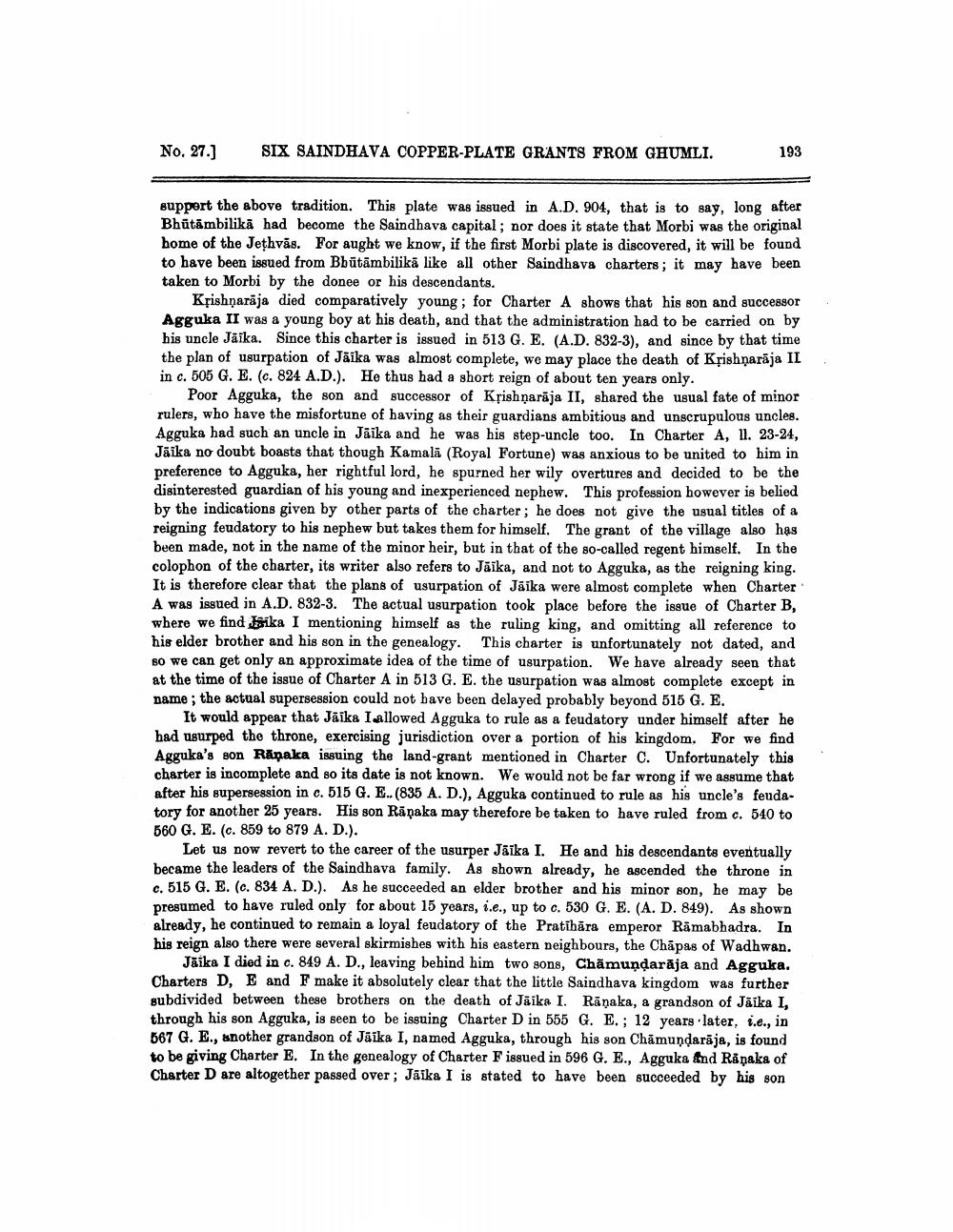________________
No. 27.]
SIX SAINDHAVA COPPER-PLATE GRANTS FROM GHUMLI.
193
support the above tradition. This plate was issued in A.D. 904, that is to say, long after Bhūtāmbilikā had become the Saindhava capital; nor does it state that Morbi was the original home of the Jethvās. For aught we know, if the first Morbi plate is discovered, it will be found to have been issued from Bbūtāmbilikā like all other Saindhava charters; it may have been taken to Morbi by the donee or his descendants.
Krishnaraja died comparatively young; for Charter A shows that his son and successor Agguka II was a young boy at his death, and that the administration had to be carried on by his uncle Jāika. Since this charter is issued in 513 G. E. (A.D. 832-3), and since by that time the plan of usurpation of Jāika was almost complete, we may place the death of Kțishộarāja IL in c. 505 G. E. (c. 824 A.D.). He thus had a short reign of about ten years only.
Poor Agguka, the son and successor of Krishnaraja II, shared the usual fate of minor rulers, who have the misfortune of having as their guardians ambitious and unscrupulous uncles. Agguka had such an uncle in Jäika and he was his step-uncle too. In Charter A, ll. 23-24, Jāika no doubt boasts that though Kamalā (Royal Fortune) was anxious to be united to him in preference to Agguka, her rightful lord, he spurned her wily overtures and decided to be the disinterested guardian of his young and inexperienced nephew. This profession however is belied by the indications given by other parts of the charter; he does not give the usual titles of a reigning feudatory to his nephew but takes them for himself. The grant of the village also has been made, not in the name of the minor heir, but in that of the so-called regent himself. In the colophon of the charter, its writer also refers to Jäika, and not to Agguka, as the reigning king. It is therefore clear that the plans of usurpation of Jāika were almost complete when Charter A was issued in A.D. 832-3. The actual usurpation took place before the issue of Charter B, where we find wika I mentioning himself as the ruling king, and omitting all reference to his elder brother and his son in the genealogy. This charter is unfortunately not dated, and so we can get only an approximate idea of the time of usurpation. We have already seen that at the time of the issue of Charter A in 513 G. E. the usurpation was almost complete except in name; the actual supersession could not have been delayed probably beyond 515 G. E.
It would appear that Jāika I allowed Agguka to rule as a feudatory under himself after he had usurped the throne, exercising jurisdiction over a portion of his kingdom. For we find Agguka's son Ránaka issuing the land-grant mentioned in Charter C. Unfortunately this charter is incomplete and so its date is not known. We would not be far wrong if we assume that after his supersession in c. 515 G. E. (835 A. D.), Agguka continued to rule as his uncle's feudatory for another 25 years. His son Rāņaka may therefore be taken to have ruled from c. 540 to 560 G. E. (c. 859 to 879 A. D.).
Let us now revert to the career of the usurper Jāika I. He and his descendants eventually became the leaders of the Saindhava family. As shown already, he ascended the throne in c. 515 G. E. (c. 834 A. D.). As he succeeded an elder brother and his minor son, he may be presumed to have ruled only for about 15 years, i.e., up to c. 530 G. E. (A. D. 849). As shown already, he continued to remain a loyal feudatory of the Pratibāra emperor Rāmabhadra. In his reign also there were several skirmishes with his eastern neighbours, the Chāpas of Wadhwan.
Jāika I died in c. 849 A. D., leaving behind him two sons, Chamundarāja and Agguka. Charters D, E and I make it absolutely clear that the little Saindhava kingdom was further gubdivided between these brothers on the death of Jāika I. Rāņaka, a grandson of Jāika I, through his son Agguka, is seen to be issuing Charter D in 555 G. E. ; 12 years later, i.e., in 567 G. E., another grandson of Jāika I, named Agguka, through his son Chămundarāja, is found to be giving Charter E. In the genealogy of Charter F issued in 596 G. E., Agguka And Rånaka of Charter D are altogether passed over ; Jāika I is stated to have been succeeded by his son




